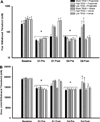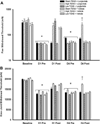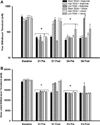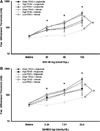Cholecystokinin receptors mediate tolerance to the analgesic effect of TENS in arthritic rats
- PMID: 19944533
- PMCID: PMC3954516
- DOI: 10.1016/j.pain.2009.10.011
Cholecystokinin receptors mediate tolerance to the analgesic effect of TENS in arthritic rats
Abstract
Transcutaneous electrical nerve stimulation (TENS) is a treatment for pain that involves placement of electrical stimulation through the skin for pain relief. Previous work from our laboratory shows that repeated application of TENS produces analgesic tolerance by the fourth day and a concomitant cross-tolerance at spinal opioid receptors. Prior pharmacological studies show that blockade of cholecystokinin (CCK) receptors systemically and spinally prevents the development of analgesic tolerance to repeated doses of opioid agonists. We therefore hypothesized that systemic and intrathecal blockade of CCK receptors would prevent the development of analgesic tolerance to TENS, and cross-tolerance at spinal opioid receptors. In animals with knee joint inflammation (3% kaolin/carrageenan), high (100Hz) or low frequency (4Hz) TENS was applied daily and the mechanical withdrawal thresholds of the muscle and paw were examined. We tested thresholds before and after inflammation, and before and after TENS. Animals treated systemically, prior to TENS, with the CCK antagonist, proglumide, did not develop tolerance to repeated application of TENS on the fourth day. Spinal blockade of CCK-A or CCK-B receptors blocked the development of tolerance to high and low frequency TENS, respectively. In the same animals we show that spinal blockade of CCK-A receptors prevents cross-tolerance at spinal delta-opioid receptors that normally occurs with high frequency TENS; and blockade of CCK-B receptors prevents cross-tolerance at spinal mu-opioid receptors that normally occurs with low frequency TENS. Thus, we conclude that blockade of CCK receptors prevents the development of analgesic tolerance to repeated application of TENS in a frequency-dependent manner.
Copyright 2009 International Association for the Study of Pain. All rights reserved.
Conflict of interest statement
No commercial party having a direct financial interest in the results of the research supporting this article has or will confer a benefit upon the authors or upon any organization with which the authors are associated.
Figures






Similar articles
-
Blockade of NMDA receptors prevents analgesic tolerance to repeated transcutaneous electrical nerve stimulation (TENS) in rats.J Pain. 2008 Mar;9(3):217-25. doi: 10.1016/j.jpain.2007.10.010. Epub 2007 Dec 3. J Pain. 2008. PMID: 18061543 Free PMC article.
-
Modulation between high- and low-frequency transcutaneous electric nerve stimulation delays the development of analgesic tolerance in arthritic rats.Arch Phys Med Rehabil. 2008 Apr;89(4):754-60. doi: 10.1016/j.apmr.2007.11.027. Arch Phys Med Rehabil. 2008. PMID: 18374009 Free PMC article.
-
Development of opioid tolerance with repeated transcutaneous electrical nerve stimulation administration.Pain. 2003 Mar;102(1-2):195-201. doi: 10.1016/s0304-3959(02)00381-0. Pain. 2003. PMID: 12620611
-
[Interactions between central opioidergic and cholecystokininergic systems in rats: possible significance for the development of of opioid tolerance].Bull Acad Natl Med. 1998;182(2):311-24. Bull Acad Natl Med. 1998. PMID: 9648346 Review. French.
-
Mechanisms of opioid-induced tolerance and hyperalgesia.Pain Manag Nurs. 2007 Sep;8(3):113-21. doi: 10.1016/j.pmn.2007.02.004. Pain Manag Nurs. 2007. PMID: 17723928 Review.
Cited by
-
An investigation of the development of analgesic tolerance to TENS in humans.Pain. 2011 Feb;152(2):335-342. doi: 10.1016/j.pain.2010.10.040. Epub 2010 Dec 8. Pain. 2011. PMID: 21144659 Free PMC article. Clinical Trial.
-
Resolving Long-Standing Uncertainty about the Clinical Efficacy of Transcutaneous Electrical Nerve Stimulation (TENS) to Relieve Pain: A Comprehensive Review of Factors Influencing Outcome.Medicina (Kaunas). 2021 Apr 14;57(4):378. doi: 10.3390/medicina57040378. Medicina (Kaunas). 2021. PMID: 33919821 Free PMC article. Review.
-
Cholecystokinin receptor-1 mediates the inhibitory effects of exogenous cholecystokinin octapeptide on cellular morphine dependence.BMC Neurosci. 2012 Jun 8;13:63. doi: 10.1186/1471-2202-13-63. BMC Neurosci. 2012. PMID: 22682150 Free PMC article.
-
Using TENS for pain control: the state of the evidence.Pain Manag. 2014 May;4(3):197-209. doi: 10.2217/pmt.14.13. Pain Manag. 2014. PMID: 24953072 Free PMC article. Review.
-
Increasing intensity of TENS prevents analgesic tolerance in rats.J Pain. 2012 Sep;13(9):884-90. doi: 10.1016/j.jpain.2012.06.004. Epub 2012 Aug 1. J Pain. 2012. PMID: 22858165 Free PMC article.
References
-
- Ainsworth L, Budelier K, Clinesmith M, Fiedler A, Landstrom R, Leeper BJ, Moeller L, Mutch S, O’Dell K, Ross J, Radhakrishnan R, Sluka KA. Transcutaneous electrical nerve stimulation (TENS) reduces chronic hyperalgesia induced by muscle inflammation. Pain. 2006;120:182–187. - PubMed
-
- American Physical Therapy Association (APTA) Guide to physical therapy practice. On what concepts is the guide based? Phys Ther. 2001;81:19–25.
-
- Baber NS, Dourish CT, Hill DR. The role of CCK caerulein, and CCK antagonists in nociception. Pain. 1989;39:307–328. - PubMed
-
- Beinfeld MC, Meyer DK, Eskay RL, Jensen RT, Brownstein MJ. The distribution of cholecystokinin immunoreactivity in the central nervous system of the rat as determined by radioimmunoassay. Brain Res. 1981;212:51–57. - PubMed
-
- Bernstein ZP, Yucht S, Battista E, Lema M, Spaulding MB. Proglumide as a morphine adjunct in cancer pain management. J Pain Symptom Manage. 1998;15:314–320. - PubMed
Publication types
MeSH terms
Substances
Grants and funding
LinkOut - more resources
Full Text Sources
Research Materials

